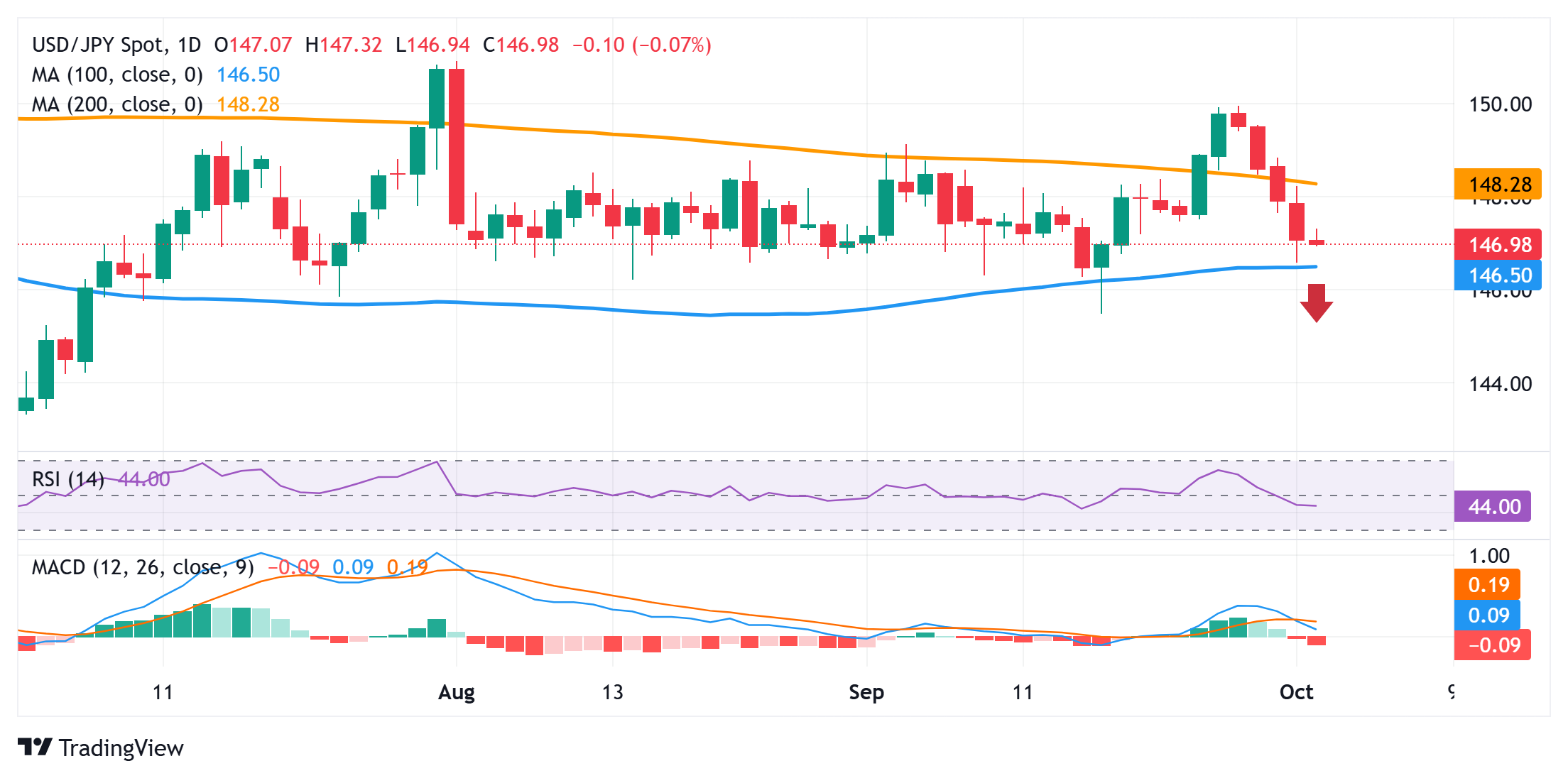Created
: 2025.10.02














![]() 2025.10.02 11:30
2025.10.02 11:30
The Japanese Yen (JPY) turns positive for the fifth straight day against its American counterpart on Thursday and remains close to a two-week high touched the previous day. The growing acceptance that the Bank of Japan (BoJ) will stick to its policy normalization path marks a significant divergence in comparison to bets that the US Federal Reserve (Fed) will lower borrowing costs two more times by the end of this year. The resultant narrowing of the US-Japan rate differential continues to benefit the lower-yielding JPY.
Meanwhile, the market reaction to the US government shutdown, so far, has been muted amid expectations of a limited impact on the economy. This remains supportive of a generally positive risk tone, which, in turn, might keep a lid on the safe-haven JPY. The US Dollar (USD), on the other hand, struggles to capitalize on the overnight bounce from a one-week low amid dovish Fed expectations. This, in turn, attracts fresh sellers around the USD/JPY pair following the Asian session uptick to the 147.25-147.30 region.

From a technical perspective, the overnight breakdown below the 147.00 mark could be seen as a key trigger for the USD/JPY bears. Moreover, oscillators on the daily chart have again started gaining negative traction, suggesting that the path of least resistance for spot prices remains to the downside. However, it will still be prudent to wait for some follow-through selling below the 100-day Simple Moving Average (SMA), currently pegged near mid-146.00s, before positioning for further losses. Spot prices might then slide to the 146.00 mark, below which the downward trajectory could extend towards the September swing low, around the 145.50-145.45 region, en route to the 145.00 psychological mark.
On the flip side, the Asian session swing high, around the 147.30 area, now seems to act as an immediate hurdle. Any further move up could be seen as a selling opportunity near the 148.00 mark and remain capped near the 200-day SMA, currently pegged near the 148.35 region. A sustained strength beyond the latter, however, might trigger a short-covering move and lift the USD/JPY pair to the 149.00 round figure. The momentum could extend further towards the 149.35-149.40 region before spot prices make a fresh attempt to conquer the 150.00 psychological mark.
The Japanese Yen (JPY) is one of the world's most traded currencies. Its value is broadly determined by the performance of the Japanese economy, but more specifically by the Bank of Japan's policy, the differential between Japanese and US bond yields, or risk sentiment among traders, among other factors.
One of the Bank of Japan's mandates is currency control, so its moves are key for the Yen. The BoJ has directly intervened in currency markets sometimes, generally to lower the value of the Yen, although it refrains from doing it often due to political concerns of its main trading partners. The BoJ ultra-loose monetary policy between 2013 and 2024 caused the Yen to depreciate against its main currency peers due to an increasing policy divergence between the Bank of Japan and other main central banks. More recently, the gradually unwinding of this ultra-loose policy has given some support to the Yen.
Over the last decade, the BoJ's stance of sticking to ultra-loose monetary policy has led to a widening policy divergence with other central banks, particularly with the US Federal Reserve. This supported a widening of the differential between the 10-year US and Japanese bonds, which favored the US Dollar against the Japanese Yen. The BoJ decision in 2024 to gradually abandon the ultra-loose policy, coupled with interest-rate cuts in other major central banks, is narrowing this differential.
The Japanese Yen is often seen as a safe-haven investment. This means that in times of market stress, investors are more likely to put their money in the Japanese currency due to its supposed reliability and stability. Turbulent times are likely to strengthen the Yen's value against other currencies seen as more risky to invest in.
![]()
Created
: 2025.10.02
![]()
Last updated
: 2025.10.02

FXStreet is a forex information website, delivering market analysis and news articles 24/7.
It features a number of articles contributed by well-known analysts, in addition to the ones by its editorial team.
Founded in 2000 by Francesc Riverola, a Spanish economist, it has grown to become a world-renowned information website.
We hope you find this article useful. Any comments or suggestions will be greatly appreciated.
We are also looking for writers with extensive experience in forex and crypto to join us.
please contact us at [email protected].
Disclaimer:
All information and content provided on this website is provided for informational purposes only and is not intended to solicit any investment. Although all efforts are made in order to ensure that the information is correct, no guarantee is provided for the accuracy of any content on this website. Any decision made shall be the responsibility of the investor and Myforex does not take any responsibility whatsoever regarding the use of any information provided herein.
The content provided on this website belongs to Myforex and, where stated, the relevant licensors. All rights are reserved by Myforex and the relevant licensors, and no content of this website, whether in full or in part, shall be copied or displayed elsewhere without the explicit written permission of the relevant copyright holder. If you wish to use any part of the content provided on this website, please ensure that you contact Myforex.
Myforex uses cookies to improve the convenience and functionality of this website. This website may include cookies not only by us but also by third parties (advertisers, log analysts, etc.) for the purpose of tracking the activities of users. Cookie policy